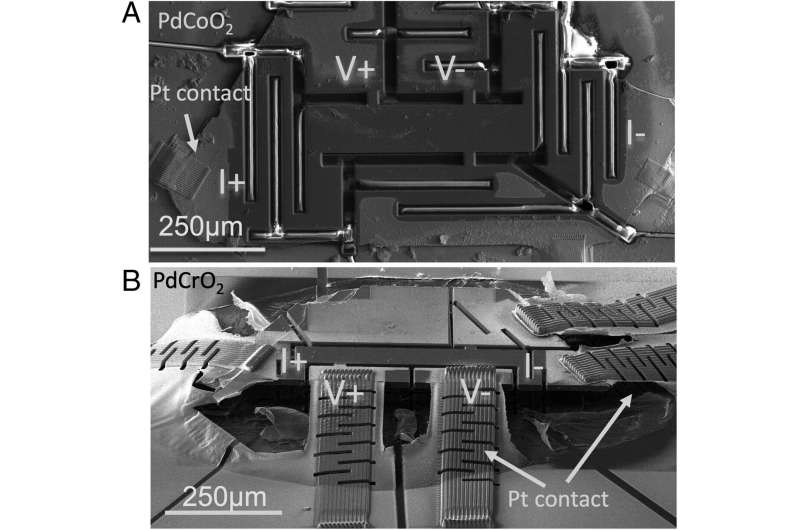This article has been reviewed according to Science X's editorial process and policies. Editors have highlighted the following attributes while ensuring the content's credibility:
fact-checked
peer-reviewed publication
trusted source
proofread
Comparing 'sister' compounds may hold key to quantum puzzle in superconducting materials

For years, physicists have been trying to explain a quantum phenomenon that occurs in a large class of superconducting materials: Electrons in so-called "strange metals" scatter at high rates in ways affected by temperature. Figuring out why this happens in certain unconventional metals could hold the keys to many quantum material puzzles, including high-temperature superconductivity, long sought after by physicists for a more efficient means of electrical energy transfer.
In two new papers, an international collaboration of researchers including Cornell physicists explain, on the microscopic level, why such "Planckian" scattering occurs in the compound PdCrO2 while it does not in its nearly identical "sister" PdCoO2.
Planckian scattering, the rate at which electrons bump into material imperfections and each other, increases linearly with temperature. Using a comparison of PdCrO2 and PdCoO2—which are very clean crystals with well-documented properties—the researchers give for the first time a quantitatively accurate description of the origin of the mysterious "Planckian scattering rate" in strongly interacting metals.
"T-linear Resistivity From Magneto-Elastic Scattering: Application to PdCrO2" published Aug. 28 in Proceedings of the National Academy of Sciences (PNAS).
In numerous strange metals, the characteristic time between electron collisions, with each other and against anything that they encounter in their path, is set by the Planck's constant and the temperature, said Debanjan Chowdhury, assistant professor of physics in the College of Arts and Sciences and a co-author of the paper. A vast majority of the known high-temperature superconductors, when heated above their superconducting temperature, exhibit this property.
This is why it has been believed for a while that the clue to understanding the origin of high-temperature superconductivity lies in understanding the common thread across these materials that leads to this universal Planckian time scale.
"The motivation behind this joint theory and experiment collaboration was to have at least one material example where every property relevant for electrical transport is known accurately, and to build a microscopic theory for the origin of Planckian scattering times," Chowdhury said.
"As far as I know, this is one of the first unconventional compounds where we have a quantitative theory for transport starting from a microscopic model of the material, which already happens to be in great agreement with the experiment."
With high stakes for applying this toward very efficient energy use, there's a huge effort in condensed matter physics to understand the cause, Chowdhury said. "The unfortunate thing is that these superconducting materials are really difficult to understand and model theoretically," he said. "So our hope was to first focus on a simpler, clean and really well-characterized material to build up a theory for this phenomenon."
The material of choice, PdCrO2, is a magnetic "delafossite" (a kind of chromium oxide mineral) that Chowdhury calls a paradigmatic example of an "interesting correlated material" with two species of electrons: a set of mobile electrons that conduct electricity freely, and another set of immobile electrons that display magnetism. The electron magnetism in PdCrO2 is key; in the sister compound PdCoO2, everything looks the same except there is no hint of magnetism. In PdCrO2 electrical transport is Planckian, while in PdCoO2 it is not.
But the magnetism itself is not all it takes to explain the origin of Planckian timescales.
"The crucial piece of the puzzle turns out to be an unexpected cooperative process where electrons interact concomitantly with the vibrations of the crystal and the localized spins—the fundamental building blocks of magnetism," said Juan Felipe Mendez Valderrama, doctoral student in physics and co-lead author with Evyatar Tulipman of Israel's Weizmann Institute of Science.
"We can now seek new candidate materials where this previously ignored interaction plays a dominant role, and by altering one of these ingredients we can drive entirely new phenomena."
Erez Berg of the Weizmann Institute of Science, Elina Zhakina of the Max Planck Institute and Andrew P. MacKenzie of the University of St. Andrews are co-authors on this collaboration. Chowdhury and Berg, long-time collaborators, decided to join forces in summer 2022 when they discovered serendipitously that they had the same set of ideas for resolving the experimental puzzle while attending a summer workshop at the Aspen Center for Physics.
The experimental study which motivated the theory, "Investigation of Planckian Behavior in a High-Conductivity Oxide: PdCrO2," also published Aug. 28 in PNAS with all the above among the authors.
"Our study has identified an inevitable, and previously ignored, source of scattering for the electrons, in delafossite materials," Chowdhury said. "While we focused on a specific material, many of these considerations are equally relevant for a host of other, possibly more complicated materials. Our hope is that the new understanding will lead to fundamental insights into a larger class of materials where electrical transport displays the mysterious Planckian timescale."
More information: J. F. Mendez-Valderrama et al, T-linear resistivity from magneto-elastic scattering: Application to PdCrO 2, Proceedings of the National Academy of Sciences (2023). DOI: 10.1073/pnas.2305609120
Elina Zhakina et al, Investigation of Planckian behavior in a high-conductivity oxide: PdCrO 2, Proceedings of the National Academy of Sciences (2023). DOI: 10.1073/pnas.2307334120
Journal information: Proceedings of the National Academy of Sciences
Provided by Cornell University





















